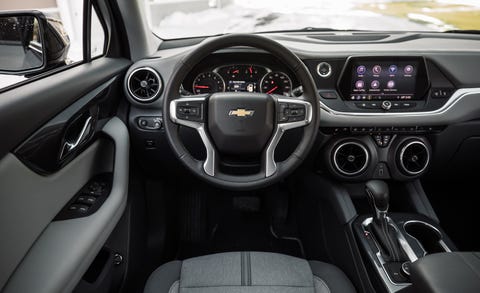A 228-hp turbo four-cylinder is the base engine of the 2022 Chevrolet Blazer, and all models offer front- or all-wheel drive, but no combination is very fuel-efficient. Still, compared with most of its two- and three-row classmates, the Blazer is better to drive thanks to accurate steering, confident cornering stability, and strong brakes.
Although the 2022 Chevrolet Blazer boasts lots of space for people and cargo, the cabin suffers from some cheap bits, and outward visibility is compromised. With pricey upper trim levels that hoard the most desirable features, the 2022 Blazer also isn’t a great value.
Engine, Transmission, and Performance
The 2022 Chevrolet Blazer features a standard a 228-hp turbocharged 2.0-liter four-cylinder and an optional 308-hp 3.6-liter V-6. Both pair with a nine-speed automatic transmission and either front- or all-wheel drive. The front-drive, turbo-four version has sufficient power for getting around town and highway duty.
However, the V-6 delivers impressive acceleration and provides added confidence when passing on the highway. Quick as the last Blazer RS we tested was, the automatic transmission was slow to downshift when we wanted a quick burst of acceleration. The four-cylinder can tow up to 1500 pounds, while the V-6 version can handle up to 4500 pounds. With steady composure and accurate steering, the Blazer is easily the best-driving crossover to wear the Chevrolet bow tie.
it was confident and responsive on twisty sections of road, especially the RS model, which has exclusive steering and suspension tuning. Even without the sportier setup found on the RS, the Blazer is more engaging than many competitors. Its standard 18-inch wheel-and-tire combo provided a smoother and quieter ride than the RS model that wore large 21-inchers, which thudded over bumpy roads. Thankfully, both models remained hushed on even surfaces and at highway speed.
The steering’s precise feedback was satisfying during spirited sessions yet fluid at low speed. The firm brake pedal immediately responded to our inputs, and the brakes brought our Blazer RS test vehicle to a stop from 70 mph in an impressive 165 feet.

